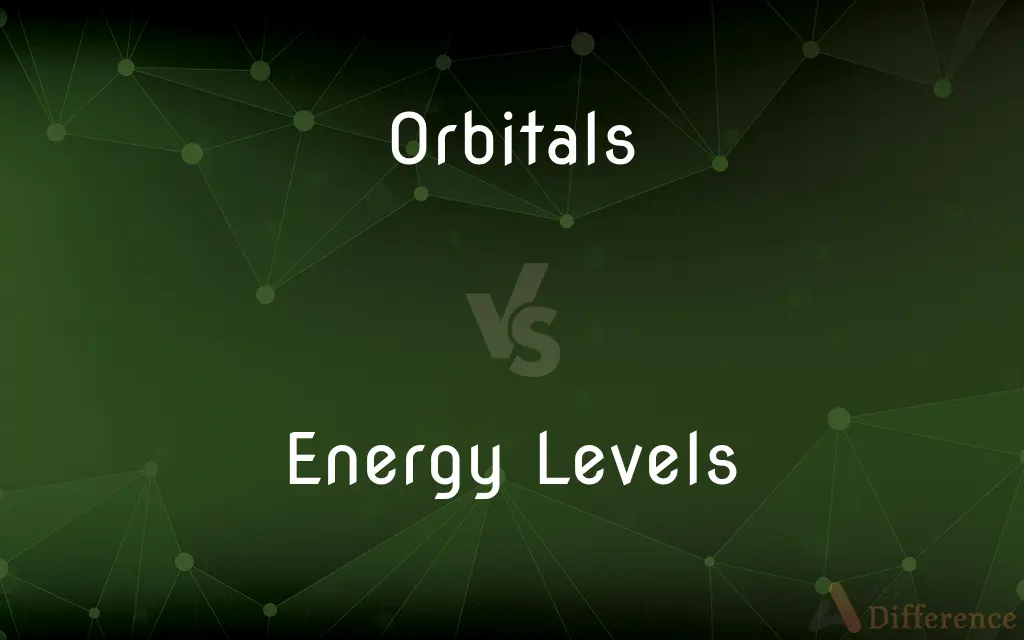Orbitals vs. Energy Levels — What's the Difference?
Edited by Tayyaba Rehman — By Fiza Rafique — Published on December 23, 2023
Orbitals are regions around a nucleus where electrons are likely found, while energy levels are specific distances from the nucleus where electrons can exist.

Difference Between Orbitals and Energy Levels
Table of Contents
ADVERTISEMENT
Key Differences
Orbitals are fundamental concepts in quantum mechanics. They represent the regions in an atom where an electron is most likely to be found. These regions give a probability distribution for an electron's position, rather than a precise location. On the other hand, energy levels refer to the specific distances from the nucleus where electrons can reside. Each energy level can contain a set number of electrons, and these levels are often visualized as shells around the nucleus.
In the context of an atom, orbitals can be thought of as the specific addresses or rooms where electrons live. They have distinct shapes like s, p, d, and f, dictating where electrons can exist in three-dimensional space. Energy levels, in comparison, are like the floors of a building. Each floor can have multiple rooms (or orbitals), and higher floors (higher energy levels) can accommodate more rooms.
The idea of orbitals evolved from the need to understand electron behavior on a quantum level. They encapsulate the wave-like nature of electrons and highlight the principle that electrons don't move in predictable paths, as once believed. Energy levels, on the other hand, are a broader concept, establishing that electrons exist in quantized, layered regions around the nucleus.
Notably, within each energy level, multiple orbitals can exist. For instance, the first energy level contains only the s orbital, while the second energy level includes both s and p orbitals. Thus, while orbitals specify electron locations within an energy level, energy levels themselves denote the overall regions around the nucleus.
To illustrate further, consider the third energy level of an atom. This energy level can encompass s, p, and d orbitals, illustrating the diversity of electron locations within a single energy level. Meanwhile, energy levels define the energy an electron has, with electrons in higher energy levels having more energy than those in lower levels.
ADVERTISEMENT
Comparison Chart
Definition
Regions where electrons are likely found
Distances from the nucleus where electrons reside
Conceptual Representation
Rooms in a building
Floors of a building
Quantum Numbers
Described by three (n, l, m_l)
Described by one (n)
Shapes
S, p, d, f, etc.
Circular shells around the nucleus
Capacity
Each orbital can hold 2 electrons
Each level's capacity increases with its number
Compare with Definitions
Orbitals
Orbitals can be visualized as specific shapes like s, p, d, and f.
In diagrams, p orbitals often look like dumbbells.
Energy Levels
Energy levels represent specific distances from an atom's nucleus.
Electrons in higher energy levels are farther from the nucleus.
Orbitals
Orbitals are 3D regions around a nucleus predicting electron locations.
The s and p orbitals differ significantly in shape.
Energy Levels
Energy levels are denoted by the principal quantum number, n.
The third energy level corresponds to n=3.
Orbitals
Each orbital can hold a maximum of two electrons.
The 1s orbital is filled with two electrons in helium.
Energy Levels
Energy levels can contain multiple orbitals.
The second energy level houses both s and p orbitals.
Orbitals
Orbitals encapsulate the wave-like nature of electrons.
Understanding orbitals is key in quantum mechanics.
Energy Levels
Energy levels are quantized regions in atoms.
Electrons cannot exist between two energy levels.
Orbitals
Orbitals are defined by three quantum numbers: n, l, and m_l.
Different orbitals have distinct quantum number combinations.
Energy Levels
Electrons in higher energy levels possess more energy.
Electrons jump to higher energy levels when they absorb energy.
Orbitals
Of or relating to an orbit.
Orbitals
The wave function of an electron in an atom or molecule, indicating the electron's probable location.
Orbitals
Plural of orbital
Common Curiosities
What do orbitals represent?
Orbitals represent regions in an atom where electrons are most likely to be found.
Are the shapes of all orbitals the same?
No, orbitals can have different shapes like s, p, d, and f.
How do energy levels differ from orbitals?
Energy levels are broad layers around the nucleus, while orbitals are specific regions within these levels.
Can an orbital exist outside an energy level?
No, orbitals are components of energy levels.
Can two orbitals overlap in an atom?
Yes, orbitals can overlap, leading to bonding in molecules.
How many orbitals are in the first energy level?
The first energy level contains only one orbital, the s orbital.
Can electrons move between energy levels?
Yes, electrons can jump between energy levels by absorbing or releasing energy.
Which has more specific information about an electron's location: orbitals or energy levels?
Orbitals provide a more specific indication of an electron's location than energy levels.
How many electrons can a single orbital hold?
Each orbital can hold a maximum of two electrons.
Are there infinite energy levels in an atom?
In theory, there are infinite energy levels, but only a few are occupied in naturally occurring atoms.
How are the shapes of orbitals determined?
Orbital shapes are determined by the wave functions derived from quantum mechanics.
What determines the energy of an electron in an atom?
The electron's energy level determines its energy.
Why are orbitals crucial in quantum mechanics?
Orbitals help explain the probabilistic, wave-like behavior of electrons.
Why is understanding both orbitals and energy levels essential in chemistry?
Understanding orbitals and energy levels is key to predicting chemical behavior and bonding.
Which holds more electrons: the second energy level or the third energy level?
The third energy level can hold more electrons than the second.
Share Your Discovery

Previous Comparison
Skimmed Milk vs. Toned Milk
Next Comparison
Z-Test vs. Chi-SquareAuthor Spotlight
Written by
Fiza RafiqueFiza Rafique is a skilled content writer at AskDifference.com, where she meticulously refines and enhances written pieces. Drawing from her vast editorial expertise, Fiza ensures clarity, accuracy, and precision in every article. Passionate about language, she continually seeks to elevate the quality of content for readers worldwide.
Edited by
Tayyaba RehmanTayyaba Rehman is a distinguished writer, currently serving as a primary contributor to askdifference.com. As a researcher in semantics and etymology, Tayyaba's passion for the complexity of languages and their distinctions has found a perfect home on the platform. Tayyaba delves into the intricacies of language, distinguishing between commonly confused words and phrases, thereby providing clarity for readers worldwide.
















































